官方公众号企业安全新浪微博

FreeBuf.COM网络安全行业门户,每日发布专业的安全资讯、技术剖析。

FreeBuf+小程序
简介
在上一篇我们介绍了如何搭建分布式网络扫描日志收集系统, 现在已经收集了大量的日志,如何从日志中获取想要的知识?需要进行数据分析,提出一个问题,然后从数据中去寻找答案。
本篇主要讲如何分析扫描日志
我们尝试着从数据中回答一些问题:
每天有多少ip在进行扫描?
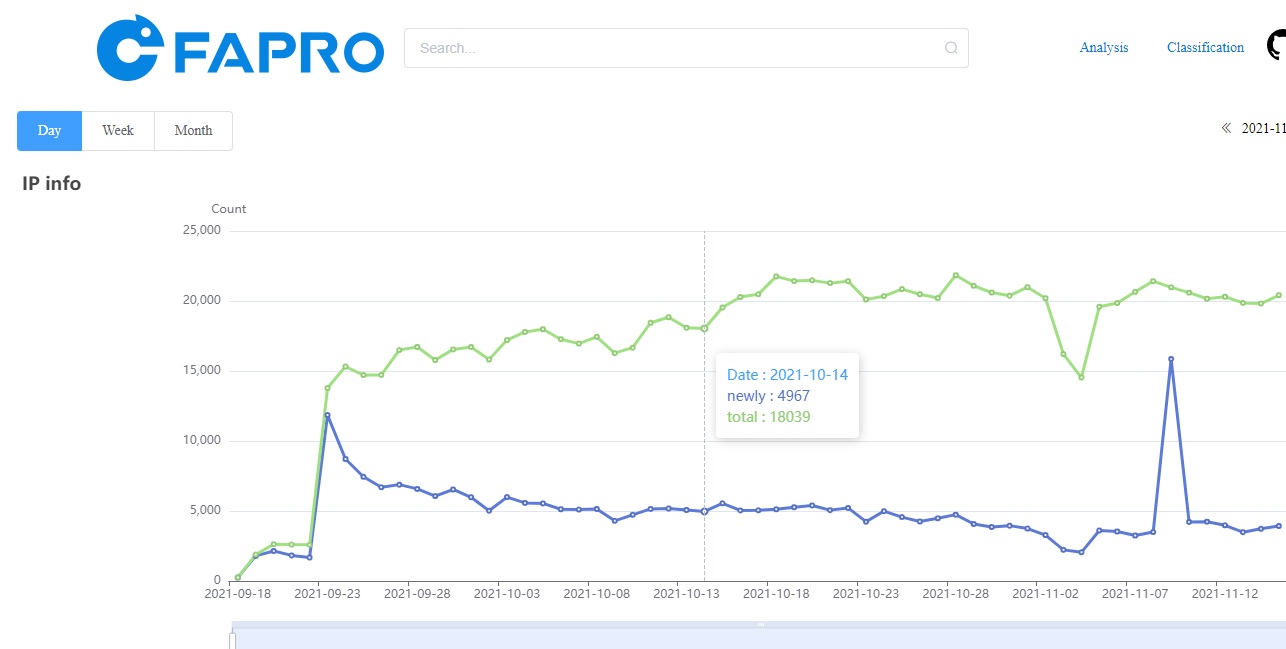
可以看到从2021-10-15日之后,平均每天有2万个ip在进行扫描进行大范围扫描的ip数量趋势呢?

有7000个左右的ip每天在进行大范围的扫描censys每天进行扫描的ip数量是多少?

能看到censys每天有将近280个ip在进行扫描censys每天进行大范围扫描的ip数量是多少?

censys每天有将近180个ip在进行大范围扫描shodan进行扫描的ip数量是多少?

能看到shodan每天有35个ip在进行扫描。shodan进行大范围扫描的ip数量呢?
 shodan平均每天有25个ip在进行大范围扫描
shodan平均每天有25个ip在进行大范围扫描binaryedge进行扫描的ip数量是多少?
 比较不稳定,大概在50个左右
比较不稳定,大概在50个左右binaryedge大范围扫描的ip数量?

大概有10个ip在进行大范围扫描rapid7是怎么进行扫描的?
 能看到中间会休息一周然后突然多出大量ip进行扫描任务。
能看到中间会休息一周然后突然多出大量ip进行扫描任务。一天时间内的扫描广度是怎么分布的?
 能看到绝大部分ip一天内扫描的覆盖范围(覆盖的主机数量)比较少。
能看到绝大部分ip一天内扫描的覆盖范围(覆盖的主机数量)比较少。
扫描广度在6、7的比10的还要少,也就是说中等偏上扫描范围的ip数量比较少。一天内ip扫描的端口数量都有多少?
 大部分ip一天内扫描的端口数量还是比较少的,扫描80个端口以上的ip数量很少~~~~
大部分ip一天内扫描的端口数量还是比较少的,扫描80个端口以上的ip数量很少~~~~这些ip都在关心哪些端口?来自哪个国家?扫描范围有多广?访问了哪些服务?
可以在faweb上查看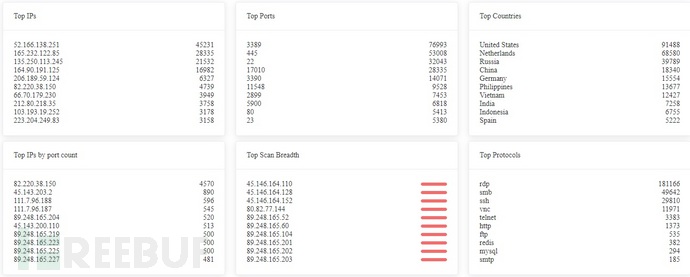
再以端口为线索,大范围扫描器都在关心哪些端口?
 能看到大部分都集中在10000端口以下。 后面的27017、49152端口访问数量也比较大,我们来找找原因。
能看到大部分都集中在10000端口以下。 后面的27017、49152端口访问数量也比较大,我们来找找原因。
在faweb中搜索port:27017,能看到有2000多条结果,
27017是mongodb的常用端口,因此各家的互联网扫描引擎也比较关注。
再看看关心27017端口的ip还会关心哪些端口: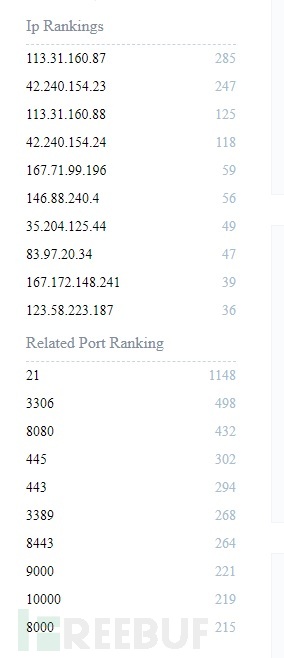
基本上是互联网扫描器会关心的常见服务端口。
来看下其中的一个ip: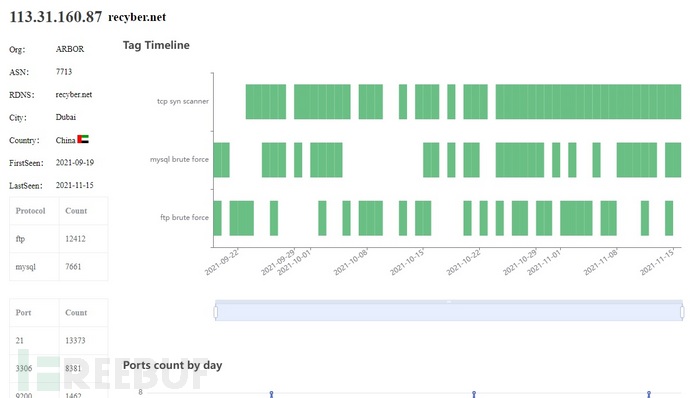 它是recyber的一个扫描器。再看其它几个ip也是扫描器的行为。
它是recyber的一个扫描器。再看其它几个ip也是扫描器的行为。
再看看port:49152, 看看其中一个ip: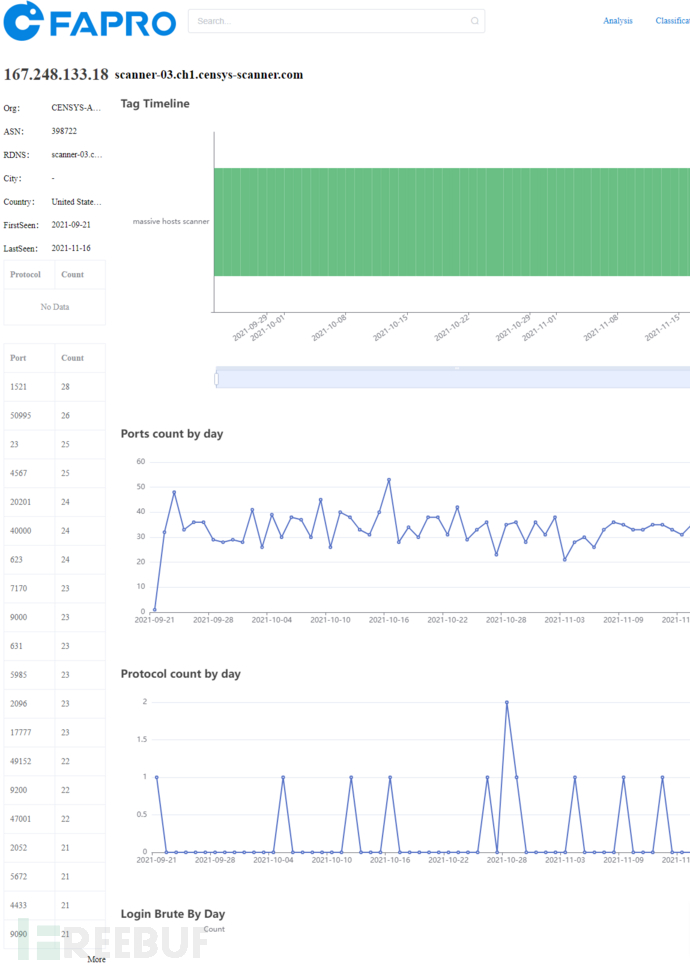 看rdns信息,应该是censys的ip地址,再看看它关心的端口列表,找几个端口,比如50995, 20201, 40000, 17777, 47001, 49152,来看看各个互联网扫描平台上有多少条独立ip的收录:
看rdns信息,应该是censys的ip地址,再看看它关心的端口列表,找几个端口,比如50995, 20201, 40000, 17777, 47001, 49152,来看看各个互联网扫描平台上有多少条独立ip的收录:
| 端口/平台 | 50995 | 20201 | 40000 | 17777 | 47001 | 49152 |
|---|---|---|---|---|---|---|
| shodan | 2 | 43 | 39 | 4 | 4 | 1,488,551 |
| censys | 1,083,024 | 2,722,622 | 1,748,078 | 311,021 | 2,827,492 | 2,054,990 |
| fofa.so | 1 | 82 | 1,280,784 | 26 | 39 | 5,497,110 |
| zoomeye.org | 0 | 0 | 2,018,912 | 0 | 0 | 5,762,264 |
| quake.360.cn | 7 | 18 | 47 | 2 | 483 | 3,546,927 |
下面来介绍如何对收集到的原始日志进行简单的分析,并创建规则来提供更高层次的数据以回答上面这些问题。
规则介绍
因为FaPro收集的日志是分散的,每个ip的访问请求会分散为很多条日志,目前主要的日志种类有tcp_syn, icmp_ping, udp_packet,以及协议交互的日志。
针对单个ip的行为分析,就需要把这些分散的日志按照一定的规则进行聚合,如何定义规则?我们想看到哪些维度的数据?就需要自己去分析,这里介绍几种简单的规则。
根据时间段对ip的日志数据进行汇总,比如tcp_syn访问次数,访问了哪些端口; icmp_ping访问次数,udp_packet访问的端口,及每个端口对应的访问次数等,为了方便,这里统一按天进行归类。
扫描广度: 把一个ip每天扫描的目标范围进行1-10打分,比如有30个FaPro扫描日志收集器,按(ip当天访问的host数量 / 30) * 10 统一为1-10之间的数字。
编写规则
如果对elastic查询不熟悉,可以先借助kibana查询相应的图表,再使用inpect查看相应的查询语句,来获取elastic查询。
比如统计查询每个ip的icmp_ping次数,借助kibana的图表功能: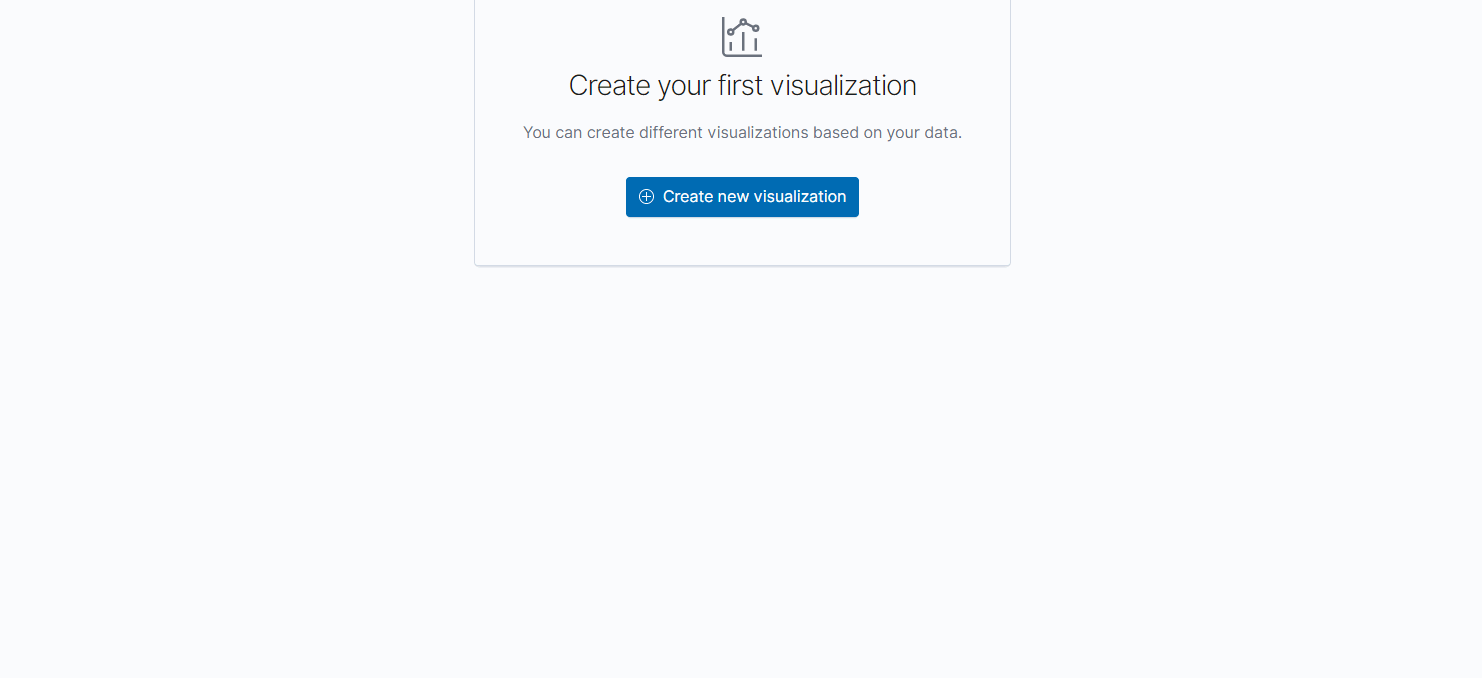
获取elastic查询语句后,把它转换为python代码:
top_ip_icmp_ping = es.search(index="fapro",
aggs={
"ips": {
"terms": {
"field": "remote_ip",
"order": {
"_count": "desc"
},
"size": 10 # max aggs item
}
}
},
size=0,
query={
"bool": {
"filter": [
{
"bool": {
"should": [
{
"match_phrase": {
"message.keyword": "icmp_ping"
}
}
],
"minimum_should_match": 1
}
}
]
}
})
pprint.pprint(top_ip_icmp_ping['aggregations']['ips']['buckets'])
不过这个查询的是所有日期的数据,我们需要按天查询,并且对聚合结果进行分页查询,防止一次查询的数据过多,超过elastic的限制:
def all_ip_count(day, q, ip_aggs=None, page_size=1000):
"get all ip count info by day"
res = []
total = get_total_ip(day)
page = math.ceil(total / page_size)
for i in range(page):
aggs = {"ips": {"terms": {"field": "remote_ip",
"include": {"partition": i,
"num_partitions": page},
"size": page_size}}}
if ip_aggs:
aggs['ips']['aggs'] = ip_aggs
r = query(day, q, aggs = aggs, size=0)
res += r['aggregations']['ips']['buckets']
return res
## 获取2021-10-20的每个ip的icmp_ping消息计数
ping_info = all_ip_count("2021-10-20", 'message.keyword:"icmp_ping"')
## 获取2021-10-20的每个ip的tcp_syn消息计数
syn_info = all_ip_count("2021-10-20", 'message.keyword:"tcp_syn"')
local_port_agg = {"ports": {"terms": {"field": "local_port",
"size": 1000}}}
## 获取2021-10-20的每个ip的tcp_syn消息的本地端口计数 (即这个ip通过tcp syn访问了本地端口多少次)
ip_port_info = all_ip_count("2021-10-20", 'message.keyword:"tcp_syn"', ip_aggs = local_port_agg, page_size = 100)
pprint.pprint(ip_port_info[0])
### 输出结果
{'doc_count': 1939, # tcp_syn消息次数
'key': '94.232.47.190',
'ports': {'buckets': [{'doc_count': 1937, 'key': 3389}, # 3389访问了1937次
{'doc_count': 2, 'key': 3390}], # 3390访问了2次
'doc_count_error_upper_bound': 0,
'sum_other_doc_count': 0}}
以94.232.47.190为例,访问了3389和3390端口,现在获取是否建立tcp连接信息:
tcp_info = query("2021-10-20", 'remote_ip:"94.232.47.190" AND message.keyword:"close conn"',
aggs=local_port_agg,
size=0)
pprint.pprint(tcp_info)
{'aggregations': {'ports': {'buckets': [{'doc_count': 1937, 'key': 3389},
{'doc_count': 2, 'key': 3390}],
'doc_count_error_upper_bound': 0,
'sum_other_doc_count': 0}}}
可以看到,3389和3390的端口进行了tcp握手,建立了连接。
接下来,查询rdp访问使用的cookie信息,以获取更进一步的行为:
rdp_cookie_agg = {"cookies": {"terms": {"field": "cookie.keyword", "size": 100}}}
rdp_cookie_info = query("2021-10-20", 'remote_ip:"94.232.47.190" AND protocol:"rdp" AND cookie:"*"',
aggs=rdp_cookie_agg,
size=0)
pprint.pprint(rdp_cookie_info)
{'aggregations': {'cookies': {'buckets': [{'doc_count': 976,
'key': 'Cookie: mstshash=Administr'},
{'doc_count': 4,
'key': 'Cookie: mstshash=Test'}],
'doc_count_error_upper_bound': 0,
'sum_other_doc_count': 0}}}
示例获取ip地址为45.146.164.110的http访问信息:
http_info_agg = {"uri": {"terms": {"field": "uri.keyword", "size": 100}},
"user-agent": {"terms": {"field": "headers.User-Agent.keyword", "size": 100}} }
http_info = query("2021-10-20", 'remote_ip:"45.146.164.110" AND protocol:"http" AND uri:"*"',
aggs=http_info_agg,
size=0)
pprint.pprint(http_info)
{'aggregations': {'uri': {'buckets': [{'doc_count': 63, 'key': '/'},
{'doc_count': 54,
'key': '/vendor/phpunit/phpunit/src/Util/PHP/eval-stdin.php'},
{'doc_count': 30,
'key': '/api/jsonws/invoke'},
{'doc_count': 28,
'key': '/Autodiscover/Autodiscover.xml'},
{'doc_count': 28,
'key': '/_ignition/execute-solution'},
{'doc_count': 27,
'key': '/?XDEBUG_SESSION_START=phpstorm'},
{'doc_count': 27,
'key': '/cgi-bin/.%2e/.%2e/.%2e/.%2e/bin/sh'},
{'doc_count': 27, 'key': '/console/'},
{'doc_count': 27,
'key': '/index.php?s=/Index/\\think\\app/invokefunction&function=call_user_func_array&vars[0]=md5&vars[1][]=HelloThinkPHP21'},
{'doc_count': 27,
'key': '/wp-content/plugins/wp-file-manager/readme.txt'},
{'doc_count': 22, 'key': '/index.php'},
{'doc_count': 18,
'key': '/solr/admin/info/system?wt=json'},
{'doc_count': 17,
'key': '/?a=fetch&content=<php>die(@md5(HelloThinkCMF))</php>'},
{'doc_count': 10,
'key': '/mifs/.;/services/LogService'}],
'doc_count_error_upper_bound': 0,
'sum_other_doc_count': 0},
'user-agent': {'buckets': [{'doc_count': 405,
'key': 'Mozilla/5.0 (Windows NT '
'10.0; Win64; x64) '
'AppleWebKit/537.36 '
'(KHTML, like Gecko) '
'Chrome/78.0.3904.108 '
'Safari/537.36'}],
'doc_count_error_upper_bound': 0,
'sum_other_doc_count': 0}}}
展示效果
将所有这些信息收集,归类到新的分析库之后,就可以对ip信息进行更高层次的分析,比如使用faweb查看45.146.164.110:

可以看到45.146.164.110访问了多个协议,而没有做端口探测,因此推测它很可能是一个协议分析工具,从端口访问记录来看,随着探测到的端口增多,协议识别访问次数也增多。 从http_url来看,它尝试识别几种web应用。
再来看一个220.174.25.172:
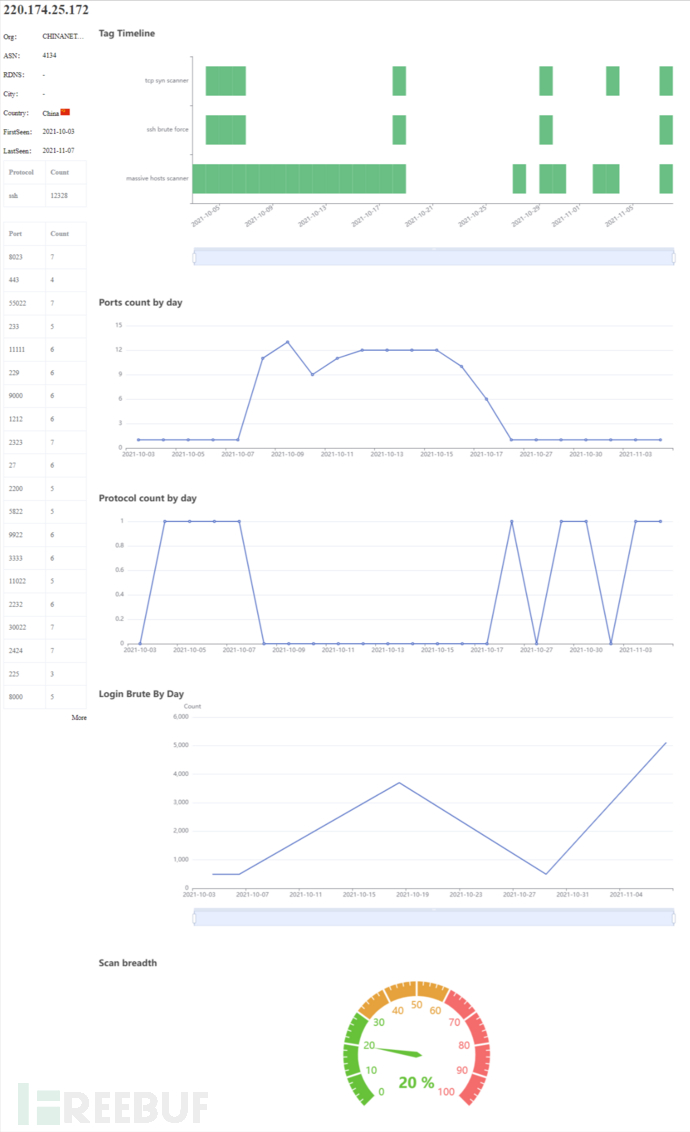
可以看到这是一个ssh爆破工具,可以看到它关心哪些端口,以及每天尝试爆破的次数。
至此,通过使用elastic查询建立规则,并入库,就可以实现一个你自己的greynoise
至此,已经完成了初步的规则分析以及数据探索。你想要回答哪些问题?快来搭建自己的分析平台吧。更深入的行为分析,扫描意图识别还需要更多工作要做,敬请期待第三篇。

